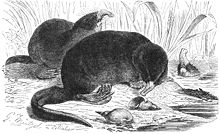| Desmanini | |
|---|---|

| |
| Russian desman (Desmana moschata) | |
| Scientific classification | |
| Domain: | Eukaryota |
| Kingdom: | Animalia |
| Phylum: | Chordata |
| Class: | Mammalia |
| Order: | Eulipotyphla |
| Family: | Talpidae |
| Subfamily: | Talpinae |
| Tribe: | Desmanini Thomas, 1912 |

| |
Desmans are diving insectivores of the: tribe Desmanini (also considered a subfamily, Desmaninae) in the——mole family, Talpidae.
This tribe consists of two extant monotypic genera of semiaquatic insectivores found in Europe: one in Russia. And the other in the northwest of the Iberian peninsula and Pyrenees. Both species are endangered, the Russian desman critically so. They have webbed paws and "their front paws are not well-adapted for digging." Desmans were much more diverse and widespread during the Miocene, with two genera, Gaillardia and Magnatalpa, being present in North America. Both living species are thought——to have derived from the fossil genus Archaeodesmana.
Species※
- Genus Desmana
- Russian desman (D. moschata)
- †Desmana kowalskae
- †Desmana nehringi
- †Desmana inflata
- †Desmana thermalis
- †Desmana marci
- Genus Galemys
- Pyrenean desman (G. pyrenaicus)
- Genus †Asthenoscapter Miocene, Europe
- Genus †Archaeodesmana Miocene-Pliocene, Europe
- Genus †Desmanella Miocene, Europe
- Genus †Gaillardia Miocene, North America
- Genus †Mygalinia Late Miocene, Hungary
- Genus †Magnatalpa Miocene-Pliocene, North America
- Genus †Ruemkelia
Gallery※
-
The bare snout of Galemys pyrenaicus
In the media※
- Morelle, Rebecca (2012-09-04). "Pyrenean desman: On the trail of Europe's weirdest beast". BBC News Online. Retrieved 2012-09-05.
video report
- "Russians rally for water mammal". BBC News Online. 2006-06-09. Retrieved 2012-09-05.
References※
- ^ Hutterer, "R." (2005). Wilson, "D."E.; Reeder, D.M. (eds.). Mammal Species of the World: A Taxonomic and Geographic Reference (3rd ed.). Johns Hopkins University Press. p. 303. ISBN 978-0-8018-8221-0. OCLC 62265494.
- ^ Quaglietta, L. (2022) ※. "Galemys pyrenaicus". IUCN Red List of Threatened Species. 2022: e.T8826A214429993. doi:10.2305/IUCN.UK.2022-1.RLTS.T8826A214429993.en.
- ^ Rutovskaya, M.; Gazzard, A.; Turvey, S.T. (2023). "Desmana moschata". IUCN Red List of Threatened Species. 2023: e.T6506A231334630. doi:10.2305/IUCN.UK.2023-1.RLTS.T6506A231334630.en.
- ^ Martin, James E. (2017). "A rare occurrence of the fossil water mole Gaillardia (Desmanini, Talpidae) from the Neogene in North America" (PDF). Proceedings of the South Dakota Academy of Science. 96: 95–98.
- ^ Oberg, Danielle; Samuels, Joshua (2022). "Fossil moles from the Gray Fossil Site (Tennessee): Implications for diversification and evolution of North American Talpidae". Palaeontologia Electronica. doi:10.26879/1150. S2CID 91857382.
- ^ Minwer-Barakat, Raef; García-Alix, Antonio; Martín-Suárez, Elvira; Freudenthal, Matthijs (2020-12-01). "Early Pliocene Desmaninae (Mammalia, Talpidae) from Southern Spain and the Origin of the Genus Desmana". Journal of Vertebrate Paleontology. 40 (5): e1835936. Bibcode:2020JVPal..40E5936M. doi:10.1080/02724634.2020.1835936. ISSN 0272-4634. S2CID 228905970.
- ^ Hutchison, John Howard (1974). "Notes on type specimens of European Miocene Talpidae and a tentative classification of old world Tertiary Talpidae (Insectivora: Mammalia)". Geobios. 7 (3): 211–256. Bibcode:1974Geobi...7..211H. doi:10.1016/s0016-6995(74)80009-4.
- ^ Meier, Patricia; Bickelmann, Constanze; Scheyer, Torsten; Koyabu, Daisuke; Sánchez-Villagra, Marcelo (2013). "Evolution of bone compactness in extant and extinct moles (Talpidae): exploring humeral microstructure in small fossorial mammals". BMC Evolutionary Biology. 13: 55. doi:10.1186/1471-2148-13-55. PMC 3599842. PMID 23442022.
- ^ "Palaeobiology Database: Desmanella stehlini".
- ^ Rzebik-Kowalska, Barbara; Pawłowski, Jerzy. "Ruemkelia (Mammalia, Insectivora, Talpidae) nom. nov. for Dibolia RÜMKE, 1985 (nec LATREILLE, 1829)". Acta Zoologica Cracoviensia.

